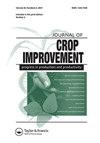Corn yield response to irrigation level, crop rotation, and irrigation system
IF 1.5
Q3 AGRONOMY
引用次数: 1
Abstract
ABSTRACT Economic sustainability is a result of efficient crop management, irrigation system selection, proper crop rotation, and crop yield. A long-term corn (Zea mays L.) yield research project was conducted in Southwest Georgia, USA (84°36”W, 30°44”N) during the 2001 to 2018 crop years, which compared four corn crop rotations, three irrigation systems, and three irrigation levels. Drip and overhead irrigation systems, along with a dryland control, were implemented. Drip systems included shallow subsurface drip (S3DI) and subsurface drip irrigation (SSDI). Irrigation levels included dryland, 33%, 50%, 62/66%, and 100% of estimated water use. Crop rotations were 1) peanut (Arachis hypogaea L.)-corn-corn, 2) peanut-corn, 3) peanut-corn-cotton, (Gossypium hirsutum L.), and 4) peanut-corn-corn-cotton. There were yield differences due to crop rotation; however, the differences were not consistent across years, irrigation levels, or irrigation systems. The SSDI system had consistently lower yield (9659 kg/ha) than both the S3DI (11,791 kg/ha) and sprinkler (12,230 kg/ha) at 100% irrigation level when averaged across all crop rotations and years. In wet years, irrigation level had no effect on yield due to total rainfall amount and timing. However, in dry years, corn yield for sprinkler and SSDI were influenced by irrigation level but not always for S3DI. When selecting an irrigation system, long-term yield should not be the only criterion but should consider crop rotation, system installation cost, field size, irrigation system controls, and irrigation and crop system management.玉米产量对灌溉水平、轮作和灌溉制度的响应
经济可持续性是有效的作物管理、灌溉系统选择、适当的作物轮作和作物产量的结果。在美国乔治亚州西南部(84°36”W, 30°44”N)进行了玉米(Zea mays L.)长期产量研究,比较了4种玉米轮作、3种灌溉制度和3种灌溉水平。实施了滴灌和架空灌溉系统,以及旱地控制。滴灌系统包括浅层地下滴灌(S3DI)和地下滴灌(SSDI)。灌溉水平包括旱地、33%、50%、62/66%和100%的估计用水量。作物轮作为:1)花生-玉米,2)花生-玉米,3)花生-玉米-棉花,4)花生-玉米-玉米-棉花。轮作造成产量差异;然而,不同年份、灌溉水平或灌溉系统的差异并不一致。在所有轮作和年份的平均水平下,SSDI系统在100%灌溉水平下的产量(9659公斤/公顷)始终低于S3DI(11791公斤/公顷)和洒水系统(12230公斤/公顷)。在丰水年,由于总降雨量和时间的关系,灌溉水平对产量没有影响。干旱年份,喷灌和SSDI玉米产量受灌溉水平影响较大,而S3DI玉米产量不受灌溉水平影响。在选择灌溉系统时,长期产量不应是唯一的标准,而应考虑作物轮作、系统安装成本、农田面积、灌溉系统控制以及灌溉和作物系统管理。
本文章由计算机程序翻译,如有差异,请以英文原文为准。
求助全文
约1分钟内获得全文
求助全文
来源期刊

Journal of Crop Improvement
Multiple-
CiteScore
3.30
自引率
7.70%
发文量
42
期刊介绍:
Journal of Crop Science and Biotechnology (JCSB) is a peer-reviewed international journal published four times a year. JCSB publishes novel and advanced original research articles on topics related to the production science of field crops and resource plants, including cropping systems, sustainable agriculture, environmental change, post-harvest management, biodiversity, crop improvement, and recent advances in physiology and molecular biology. Also covered are related subjects in a wide range of sciences such as the ecological and physiological aspects of crop production and genetic, breeding, and biotechnological approaches for crop improvement.
 求助内容:
求助内容: 应助结果提醒方式:
应助结果提醒方式:


